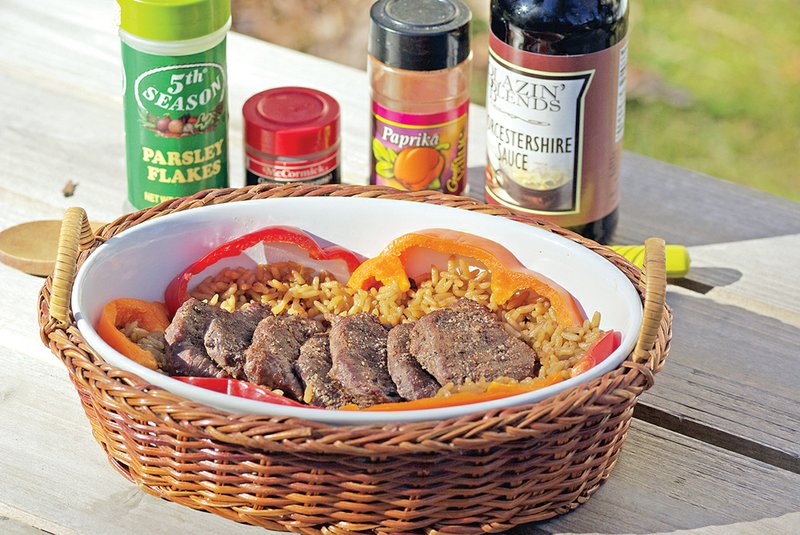When I was a teenager, I hunted deer with a group of men at a camp in eastern Arkansas. I have good memories of those times, including many revolving around camp traditions. A hunter who shot at and missed a deer, for example, could expect to have his shirt-tail cut off. A young nimrod who killed his first deer would be “blooded” by the other hunters.
Another tradition involved the first deer killed each season. That deer was the “camp deer.” The field-dressed animal was skinned, then the hunters removed the choicest cuts of venison — first, the two tenderloins lying along the backbone inside the body cavity, followed by the two, thick, boneless loins, or backstraps, on the back. Tradition dictated that these choice pieces of meat be shared with everyone in camp.
The hunter who killed the deer was usually the one who cooked it as well because everyone else was still hunting. For this reason, the method of cookery varied considerably. At times, the cook used a very simple technique — medallions of loin battered and fried in a skillet, for example, or a whole loin cooked on a spit over the campfire. At other times, the backwoods chef fawned over the meal like a caterer cooking for a soiree, whipping up special rubs or sauces to highlight the mild flavor of the venison or using savory cooking methods such as braising or grilling.
Regardless of the cooking method, plain or fancy, you could always count on one thing: the venison loin was tender and delicious. Leftovers were unheard of.
The loins are the choicest cuts of venison. The muscles from which they are formed lay on each side of the spine. They do little work, so they are the tenderest part of the deer.
When I cook venison loin for guests, I never know who’s happier with it — me or the guests. I like this boneless cut because it is easy to portion, straightforward to prepare and a breeze to carve. My guests love it because it’s never tough and always scrumptious.
It’s easy to remove the loins when butchering a deer. I start with the tenderloins, which I remove immediately after field-dressing the animal. These lie adjacent the spine inside the body cavity and are easily cut away with a sharp knife.
The loins, or backstraps, are two parallel cylinders of lean muscle lying tight against the backbone. To remove them, insert a sharp knife straight down beside the backbone where it meets the hindquarters, and, progressing toward the deer’s head, cut tightly along the
vertebrae, following the contour of the bone to the base of the neck.
Next, make a perpendicular cut across the top of the rib cage that meets the initial cut. This should be about four to six inches from the first and as deep as the rib bones. The long strip of muscle between the cuts is the loin. Grasp the upper end (near the hindquarter) of the loin with one hand and carefully slice around it with the knife, separating the loin from the ribs and backbone as you pull downward. With practice, the loins will come out quickly and easily.
I generally leave the smaller tenderloins whole until I’m ready to cook them. If you freeze them, use a vacuum packer. Otherwise the cold of the freezer will lessen their quality. A better option is cooking them fresh, not frozen, to make the most of their tenderness and flavor.
While the tenderloins require little trimming, the loins have an outer layer of fat and silverskin that should be
removed before the loin is cooked. The loin may be prepared whole, cut in half or thirds, or sliced crosswise into small steaks of a desired thickness. I like to cut mine into inch-thick disks and then butterfly each piece by cutting it about three-quarters of the way through to make it half as thick but wider. These thinner, wider cuts cook more quickly when sautéed in a pan. You also can make a cut halfway through a whole or half loin, open up the meat and stuff it with various ingredients to make a delicious roast.
About the only way you can ruin venison loin is overcooking it. It’s best when cooked rare or medium rare, but if finicky guests insist on having their meat well done, use smaller cuts so they can be cooked to varying degrees of doneness.
There are many recipes one can use to bring out the very best in these tender cuts of delicious venison. Here are two from my home recipe file sure to be hit with all who try them.
Grilled Rubbed Venison Loin
Ingredients:
1 whole venison loin
2 tablespoons Worcestershire sauce
2 tablespoons dried parsley
2 teaspoons garlic powder
2 teaspoons paprika
1 teaspoon salt
1 teaspoon fresh-ground black pepper
1/3 teaspoon cayenne pepper
Directions:
Rub the loin with Worcestershire sauce. Mix all the dry
ingredients and rub evenly on the loin. Let stand 30 minutes to 1 hour. Grill over medium heat until done to taste.
Sautéed Deer Medallions
Ingredients:
1 pound venison loin or tenderloin, sliced 1-inch thick
1 teaspoon salt
1/2 teaspoon black pepper
2 tablespoons olive oil
1/2 cup chopped onion
6 cloves garlic, minced
1/2 cup whole mushrooms
1/2 cup Dijon mustard
1/2 cup sour cream
1 tablespoon cornstarch
Directions:
Pound the loin slices to 3/4-inch thickness with a meat mallet or the flat side of a knife. Season with salt and pepper.
In a large skillet, heat the olive oil. Add the medallions of meat and sear on each side until browned, about 1 minute on each side. Transfer to a plate.
Add the onion, garlic and mushrooms to the hot skillet and sauté until the onions are translucent. Stir in the mustard and sour cream.
Mix until smooth and hot. Add cornstarch mixed in enough water to make a thick sauce. Return the venison medallions and simmer until hot.
